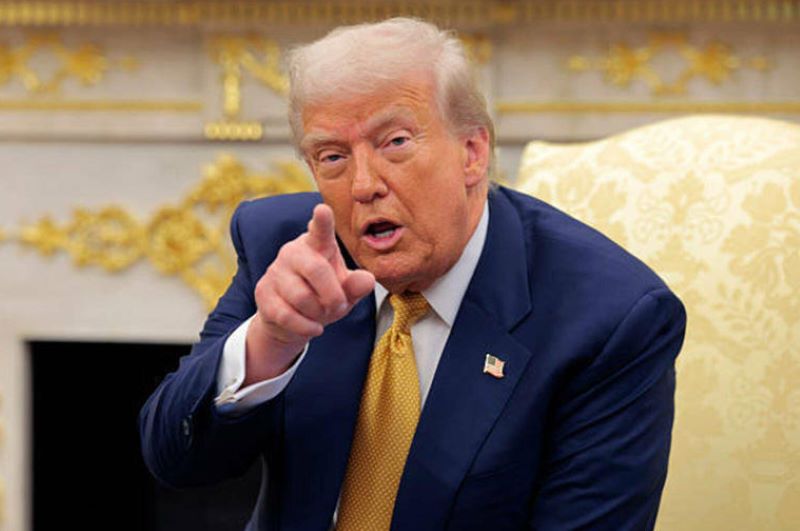Currently, the global competition in the AI field is intensifying, with the United States making frequent moves in this race. The “AI Action Plan” released by the Trump administration aims to inject new momentum into the development of AI in the U.S. through policy adjustments. Meanwhile, the “Stargate” project, launched by OpenAI, SoftBank, and Oracle, was supposed to become a crucial pillar of U.S. AI infrastructure but has fallen into a dilemma. The development trajectories of these two initiatives are not only critical to the U.S. AI strategy but also reflect the broader global AI competition.
Trump’s New AI Policy: Reshaping the Competitive Logic with “Deregulation”
On July 23, the Trump administration unveiled its “AI Action Plan,” marking the beginning of a new round of technological competition strategy in the U.S. This policy framework, centered around “deregulation,” aims to reconstruct the regulatory system, activate capital momentum, and strengthen global alliances to solidify the U.S.’s hegemonic position in the AI race. Its policy design bears the distinctive “Silicon Valley imprint” — abandoning the stricter regulatory path of the Biden administration and adopting a “carrot-and-stick” approach to release market vitality.
Domestically, the breakthrough of this plan lies in the reallocation of power between federal and state authorities. The Trump administration explicitly abolished the federal-level AI regulatory framework, allowing states to formulate rules autonomously, provided they meet basic standards. At the same time, it uses funding restrictions to curtail the autonomy of “over-regulated states.” This design directly addresses the demand from Silicon Valley companies, such as Google and Coreweave, for “policy certainty,” with announcements like the $92 billion investment reflecting an immediate response to the relaxed regulatory environment. Notably, the plan also mandates that federal procurement of large language models must be “de-ideologized,” a controversial clause that reflects a politicized interpretation of technological neutrality and hints at a struggle for control over AI content.
On the global front, the policy tightly links technology exports with geopolitical containment. By simplifying AI technology export procedures to allied countries, the U.S. seeks to create a “technological alliance barrier” to counter China’s influence. Michael Kratsios, director of the White House Office of Science and Technology Policy, stated that the goal of the policy package to be implemented in the next six months is to “ensure U.S. dominance in both economic and military AI applications.” This strategy of turning technology competition into a geopolitical tool continues the U.S.’s hegemonic thinking but injects new risks of division into its alliance system — the European Union has already stated it will not accept AI regulatory coordination based on “U.S. standards.”
The “Stargate” Dilemma: The Rift in Capital Alliances and Technological Dilemma
The “Stargate” project, initiated by OpenAI, SoftBank, and Oracle, was supposed to be the cornerstone of the U.S. AI hegemonic strategy but has become embroiled in a “loud thunder but little rain” situation. This mega-project, with a total investment of $500 billion, has only managed to secure a 4.5-gigawatt data center cooperation agreement six months after its launch, with the location and construction schedule still unclear. From an initial “investment of $100 billion this year” to “a small data center in Ohio by the end of 2025,” the goal has been significantly scaled back, revealing the intense collision between the capital alliance’s technological ambitions and the harsh realities.
The strategic rifts between the partners constitute the most direct obstacle. SoftBank insists that the data centers be connected to its invested energy companies’ power grids to secure control over the energy network, while OpenAI fears this would undermine its autonomy in power management. The two sides have been deadlocked for three months on the site selection issue. Oracle, as the intermediary, attempted to mediate but CEO Safra Catz’s public statement — “Stargate has not yet formed a real project structure” — essentially admitted the failure of coordination. Behind this divide lies a deeper conflict of interest: SoftBank aims to control project cash flow through energy network integration, OpenAI seeks to preserve technical autonomy to maintain control over its GPT models, and Oracle hopes to gain long-term service revenue from operating the data centers. The three parties’ conflicting demands are hard to reconcile.

The dual bottlenecks of funding and technology make the project difficult to advance. Despite the impressive $500 billion investment figure, the actual capital raised is less than 10%. To raise funds, SoftBank has sold its ARM stake and issued high-interest bonds, driving its debt ratio to 68%. The $30 billion annual payment agreement between OpenAI and Oracle exceeds OpenAI’s current revenue forecast by three times, forcing the company to delay some model training plans due to cash flow pressure. Technologically, the situation is just as challenging: a report by PJM, the largest electricity grid operator in the U.S., shows that the power grids in data center-intensive areas like Virginia and Ohio are already at full capacity, and new projects face the dilemma of “no electricity available.” Moreover, the cooling technology for GPU clusters exceeding 50 kW per rack is still in the experimental stage, and large-scale applications face insurmountable physical limits.
A more troubling issue is the project’s outdated technological approach. “Stargate” continues to rely on the traditional model of “power scaling,” attempting to establish competitive barriers through large-scale data centers, but neglects innovations in algorithm optimization and distributed collaboration. In contrast, Chinese companies, through breakthroughs like the R1 model, have achieved a 3x efficiency improvement with the same computational power, and their annual electricity capacity increase is 10 times that of the U.S. This technological lag suggests that even if “Stargate” moves forward as planned, it may face the awkward situation of being outdated the moment it’s completed.
The Global AI Race: Hegemonic Anxiety Under Strategic Imbalance
The intertwining of Trump’s new AI policy and the fate of the “Stargate” project reflects the deeper anxieties and strategic imbalances of the U.S. in maintaining technological hegemony. The combination of “deregulation + capital-intensive investment” seems logically coherent — the former creates a favorable development environment, while the latter solidifies the hardware foundation. However, this approach exposes the U.S.’s path dependence and systemic risks in the AI competition.
The structural contradictions within domestic governance present the first challenge. While the Trump administration tries to suppress state-level regulatory autonomy through federal policies, Congress previously vetoed a proposal to “ban state-level AI legislation for 10 years,” and technology hubs like California and New York are still pushing forward with independent regulatory frameworks. This division between federal and state governance could lead to a risk of increased compliance costs for cross-state projects like “Stargate.” For instance, the differences in data privacy standards between states could increase operational costs by over 30%.
The complexity of international competition further exacerbates the difficulty of implementing the strategy. The “Stargate” plan aims to expand influence by building data centers in allied countries but encounters challenges with data sovereignty and technology regulation. The European Union’s Digital Markets Act requires critical data localization, making it difficult for U.S. companies to maximize efficiency through cross-border computational resource allocation. Meanwhile, U.S. export controls on chips limit “Stargate’s” ability to export advanced technology to “secondary allies.” This contradictory mindset of “seeking both technological monopoly and market expansion” has led to frequent setbacks in alliance cooperation — South Korea, for example, recently announced plans to independently build its own AI infrastructure, rejecting participation in “Stargate” as a regional hub.
The single-minded focus on hardware expansion also hides the risk of strategic misjudgment. The U.S. is overly focused on hardware scale expansion, partly due to its chip industry advantages and its reliance on a “moonshot-style” centralized development model. However, the core of AI competition has long shifted from a simple computational power race to a system collaboration of “algorithms – computing power – data – energy.” China’s combination strategy of “distributed optimization + green energy” has enabled it to leapfrog ahead, which further demonstrates this point. The Trump administration’s strategy of “relaxing regulation for speed” may fall into the “high investment, low output” trap by neglecting the systematic construction of the technological ecosystem — as Stanford University’s AI Institute report points out: “For every $1 the U.S. invests in AI hardware, the marginal returns are decreasing at a rate of 15% per year.”
In this race that will define the technological landscape of the 21st century, the U.S.’s strategic choices are facing a critical test. Whether it continues to stick to the old path of capital-driven scale expansion or redefines a new paradigm that balances innovation efficiency and system stability will not only determine the fate of “Stargate” but will also shape the future direction of global AI development.












